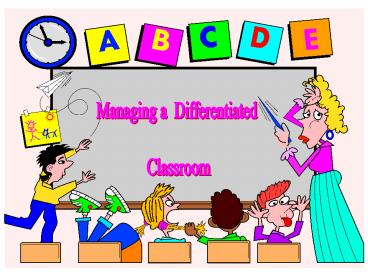Managing a Differentiated Classroom - PowerPoint PPT Presentation
1 / 19
Title:
Managing a Differentiated Classroom
Description:
Set time lines/expectations for work completion (contracts) ... Learning to Lead a Differentiated Classroom. Key Skills that a Teacher will Develop Over Time ... – PowerPoint PPT presentation
Number of Views:46
Avg rating:3.0/5.0
Title: Managing a Differentiated Classroom
1
Managing a Differentiated Classroom
Managing a Differentiated Classroom
2
Review!
- Differentiated instruction encompasses
attitudes, experiences, modes of learning,
learning levels, feelings, motivation, etc
3
Discover Yourself/Discover Your Students!
- Think about
- Your strengths/weaknesses
- How you are smart (Multiple Intelligences)
- How children learn best (Brain-Based Principals)
- Ask yourself How does my learning profile affect
the way I teach? How does this affect how my
students are learning?
4
The Teacher's Role in a Differentiated Classroom
Keepers and dispensers of knowledge
OR
Organizers of learning opportunities
5
Teacher as Director of the Orchestra
The director of the orchestra helps the musicians
make the music, but does not make the music
himself.
6
Teacher as Coach
A good coach has clear goals for the team, but
also for every individual on the team.
7
Teacher as Jazz Musician
The jazz musician has the big picture, but can
add new notes, change tempo, step back for a
soloist to assume the spotlight, or become the
soloist in the spotlight.
8
Ask Yourself...
- How do I prepare to differentiate?
- How do I prepare my students and my classroom?
- How do I manage the groups and activities?
9
Prepare Your Kids
- Use a good piece of childrens literature!
- Mrs. Spitzers Garden
- to illustrate individual needs and how everyone
must be treated differently to be treated fairly.
- Talk about expectations/structure and routines.
- You will probably have to prepare their parents
as well!
10
And Continually Assess and Revise Before You
Teach!
- Pre-assess using various tools
- Interest Inventories
- Multiple Intelligence Surveys
- Assess prior knowledge of topic/underlying
principals or skills - Other sources
- Information from grade book
- Information from tests
- Observations (kid-watching)
- Conversations/conferences with child, their
parents, and other professionals - Portfolios
- Rubrics
- Journals
11
Keep Records that Allow You to See Progress At a
glance"
- class record sheets/grids
- sticky notes in a notebook
- grouping plans
12
Where do I start?
- Start small!!!!!!!!!!!
- Target one subject or a specific unit.
- Start with what you already have.
- Share differentiated lessons with and among
colleagues. - Get ideas from books, tapes, and peers.
- Use what has been successful again next year.
- Flexible group with other classrooms/teachers (be
careful not to track) - Try one thing per week
13
Managing Student Work
- Who Goes Where?
- How Do You Set Things Up?
- How Do You Manage Directions?
- How Do You and Your Students Keep Track of Work?
14
What About Grouping?
- Try for TAPS!
- TTotal Group
- AAlone
- PPartners
- SSmall Groups
- Remember to keep it flexible and use on a as
needed basis!
15
Tips for Making it Manageable!
- Establish a grouping system (work boards).
- Tier/Color code centers based on complexity (vary
the colors from week to week so they dont catch
on). - Spend different amounts of time with different
groups (more for needy, less for less needy). - Create tasks that students can do themselves
(create checklists) - Model! Model! Model!
- Provide rubrics/samples to guide quality.
- Establish behavior guidelines for group time
(practice it once with no group in front of you). - Provide expectations and guidance for getting
help while the teacher is busy (experts and
teachers aides)
16
- Think the task through in advance/what can be
done ahead? - Put things in tubs/baggies or containers if no
space. - File folders or mail boxes for storage of
unfinished work. - Get volunteers/family members to help during
flexible group times. - Provide work cards to give instructions/provide
examples (bulletin board space?), audiotape
directions, visual directions (pictures). - Use study buddies.
- Post office hours so kids know when they can come
to you for help (help board).
17
- Use centers that are similar from week to week.
- Teach to different learning modes (through music,
body movements, classifying, etc) - Use varied texts.
- Develop Literature Circles to get kids to discuss
in depth. - Establish procedures for what to do when work is
finished. - Provide choices (choice boards/contracts).
- Set time lines/expectations for work completion
(contracts). - Use Status of the class meetings or worklogs.
- Let kids self evaluate/peer review using
checklists.
18
Learning to Lead a Differentiated Classroom
Key Skills that a Teacher will Develop Over Time
- Organizing and focusing curriculum on essential
information, understandings, and skills - Diagnosing student need crafting learning
experiences to respond to diagnoses - Seeing and reflecting on individuals as well as
the group - Structuring student work to avoid potential
problems - Sharing responsibility for teaching learning
with students - Moving students among varied work arrangements
- Keeping track of student progress toward personal
group benchmarks - Organizing materials and space
19
Ending Thoughts
- When moving towards differentiated instruction
you will find greater success if you - Have a clear rationale for differentiation
- Prepare your students and their parents for a
differentiated classroom - Attend to issues of classroom structure and
management as you move towards a more
student-centered learning - Move towards differentiation at a pace that is
comfortable to both you and your students - Plan with your colleagues who are interested in
differentiation.

